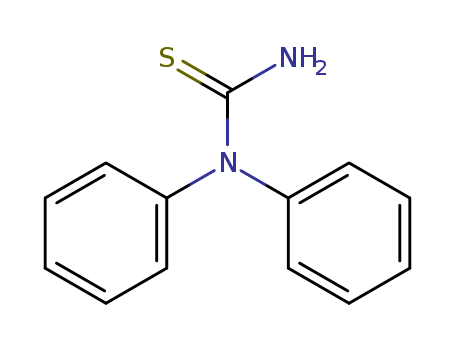- Chemical Name:1,1-Diphenyl-2-thiourea
- CAS No.:3898-08-6
- Molecular Formula:C13H12 N2 S
- Molecular Weight:228.318
- Hs Code.:2930909090
- European Community (EC) Number:223-448-0
- NSC Number:49187
- UNII:MPJ2UNH7EF
- DSSTox Substance ID:DTXSID6063228
- Nikkaji Number:J87.707G
- ChEMBL ID:CHEMBL1423001
- Mol file:3898-08-6.mol
Synonyms:1,1-Diphenyl-2-thiourea;1,1-Diphenylthiourea;3898-08-6;N,N-Diphenylthiourea;Thiourea, N,N-diphenyl-;USAF EK-7087;Urea, 1,1-diphenyl-2-thio-;Urea, 1,1-diphenylthio-;MPJ2UNH7EF;EINECS 223-448-0;NSC 49187;NSC-49187;AI3-24939;N-diphenylthiourea;NSC49187;Thiourea,N-diphenyl-;Urea,1-diphenylthio-;UNII-MPJ2UNH7EF;WLN: SUYZNR&R;Urea,1-diphenyl-2-thio-;SCHEMBL81706;MLS000688186;SCHEMBL8900621;CHEMBL1423001;DTXSID6063228;HMS1679A09;HMS2718G03;MFCD00059151;STL089891;AKOS000119988;SB80163;NCGC00245090-01;AS-11529;SMR000283844;LS-160095;CS-0214697;D0918;EN300-18676;D89743;A924543;BRD-K52381940-001-07-4;Z87002412;InChI=1/C13H12N2S/c14-13(16)15(11-7-3-1-4-8-11)12-9-5-2-6-10-12/h1-10H,(H2,14,16





